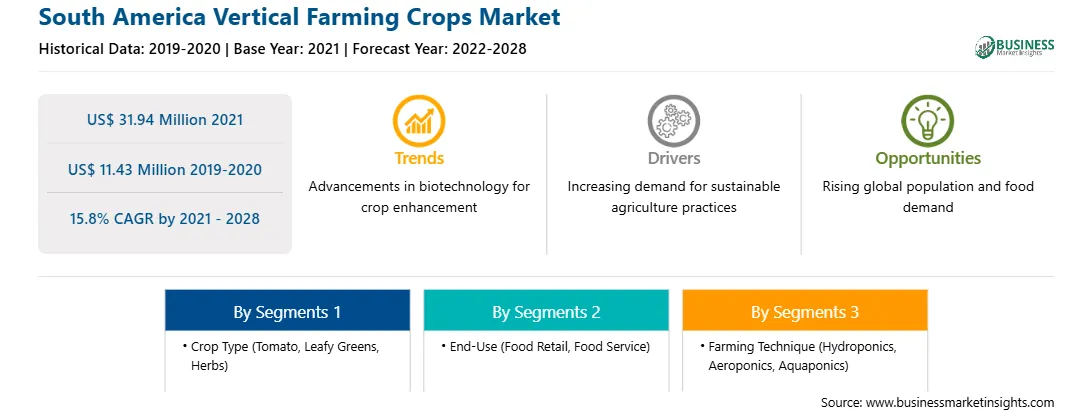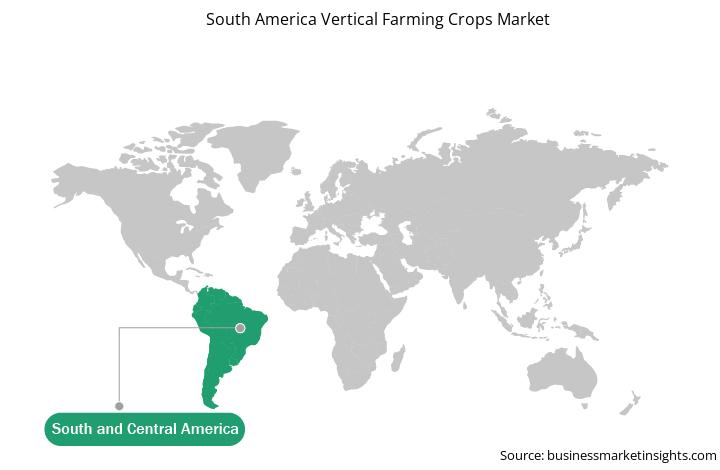Vertical farming is a massively promising agricultural technique that aims to produce more food to meet the growing population. Vertical farming includes growing crops in vertical frames or high-rise farms, saving ground space while relocating farms into urban areas, and producing nutritious crops without topsoil. The rising demand for organic food among the population triggers market growth. High usage of synthetic chemical fertilizers and pesticides in food products often leads to several health issues, including cancer, obesity, and other congenital disabilities. These factors are driving the consumers' inclination toward locally grown organic produce. Furthermore, due to the increasing focus on health and nutrition, consumers' demand for pesticide-free food products has grown exponentially. This, in turn, is fueling the demand for vertically farmed crops as they are cultivated with extreme hygiene, free of pesticides, and delivered to the retail stores within hours of harvest. Furthermore, especially in metropolitan areas, consumers are becoming more conscious about the techniques used for growing the crops and prefer food free from chemical pesticides and genetically modified organisms, thereby driving the demand for vertical farming crops across the region. Moreover, the essential nutrients in fruits and vegetables are reduced considerably during import and export. Also, most conventionally grown produce is sprayed with pesticides and fungicides. These factors drive the consumers’ inclination toward locally grown produce free from chemical fertilizers and pesticides. Besides, the food produced in vertical farms is fresh, local, suitable for environmental air quality, and pesticide-free. Therefore, the rise in demand for fresh, pesticide-free, and locally grown produce will provide huge market opportunities over the projected period.
Brazil had the highest number of COVID-19 cases, followed by Ecuador, Chile, Peru, and Argentina. South America's government had taken an array of actions to protect its citizens against the COVID-19 spread. South America faced lower export revenues, both from the drop-in commodity prices and reduction in export volumes, especially to China, Europe, and the U.S, which are important trade partners. In several South American countries, containment measures reduced economic activity in the agriculture sector for at least the next quarter. However, the players in the area come up with opportunities. For instance, to respond to the COVID-19 pandemic, Pink Farms shifted its sales online and developed a new product line, "microgreens," early-harvest leaf vegetables packed with nutrients and flavor. Pink Farms is the first vertical farm in Sao Paulo, Brazil. Such strategies are projected to uplift market growth in the coming years.
Vendors attract new customers and expand their footprints in emerging markets with the new features and technologies, thereby driving the South America vertical farming crops market. The South America vertical farming crops market is expected to grow at a significant CAGR during the forecast period.
Strategic insights for the South America Vertical Farming Crops provides data-driven analysis of the industry landscape, including current trends, key players, and regional nuances. These insights offer actionable recommendations, enabling readers to differentiate themselves from competitors by identifying untapped segments or developing unique value propositions. Leveraging data analytics, these insights help industry players anticipate the market shifts, whether investors, manufacturers, or other stakeholders. A future-oriented perspective is essential, helping stakeholders anticipate market shifts and position themselves for long-term success in this dynamic region. Ultimately, effective strategic insights empower readers to make informed decisions that drive profitability and achieve their business objectives within the market.

| Report Attribute | Details |
|---|---|
| Market size in 2021 | US$ 31.94 Million |
| Market Size by 2028 | US$ 11.43 Million |
| Global CAGR (2021 - 2028) | 15.8% |
| Historical Data | 2019-2020 |
| Forecast period | 2022-2028 |
| Segments Covered |
By Crop Type
|
| Regions and Countries Covered | South and Central America
|
| Market leaders and key company profiles |
The geographic scope of the South America Vertical Farming Crops refers to the specific areas in which a business operates and competes. Understanding local distinctions, such as diverse consumer preferences (e.g., demand for specific plug types or battery backup durations), varying economic conditions, and regulatory environments, is crucial for tailoring strategies to specific markets. Businesses can expand their reach by identifying underserved areas or adapting their offerings to meet local demands. A clear market focus allows for more effective resource allocation, targeted marketing campaigns, and better positioning against local competitors, ultimately driving growth in those targeted areas.

The South America Vertical Farming Crops Market is valued at US$ 31.94 Million in 2021, it is projected to reach US$ 11.43 Million by 2028.
As per our report South America Vertical Farming Crops Market, the market size is valued at US$ 31.94 Million in 2021, projecting it to reach US$ 11.43 Million by 2028. This translates to a CAGR of approximately 15.8% during the forecast period.
The South America Vertical Farming Crops Market report typically cover these key segments-
The historic period, base year, and forecast period can vary slightly depending on the specific market research report. However, for the South America Vertical Farming Crops Market report:
The South America Vertical Farming Crops Market is populated by several key players, each contributing to its growth and innovation. Some of the major players include:
The South America Vertical Farming Crops Market report is valuable for diverse stakeholders, including:
Essentially, anyone involved in or considering involvement in the South America Vertical Farming Crops Market value chain can benefit from the information contained in a comprehensive market report.